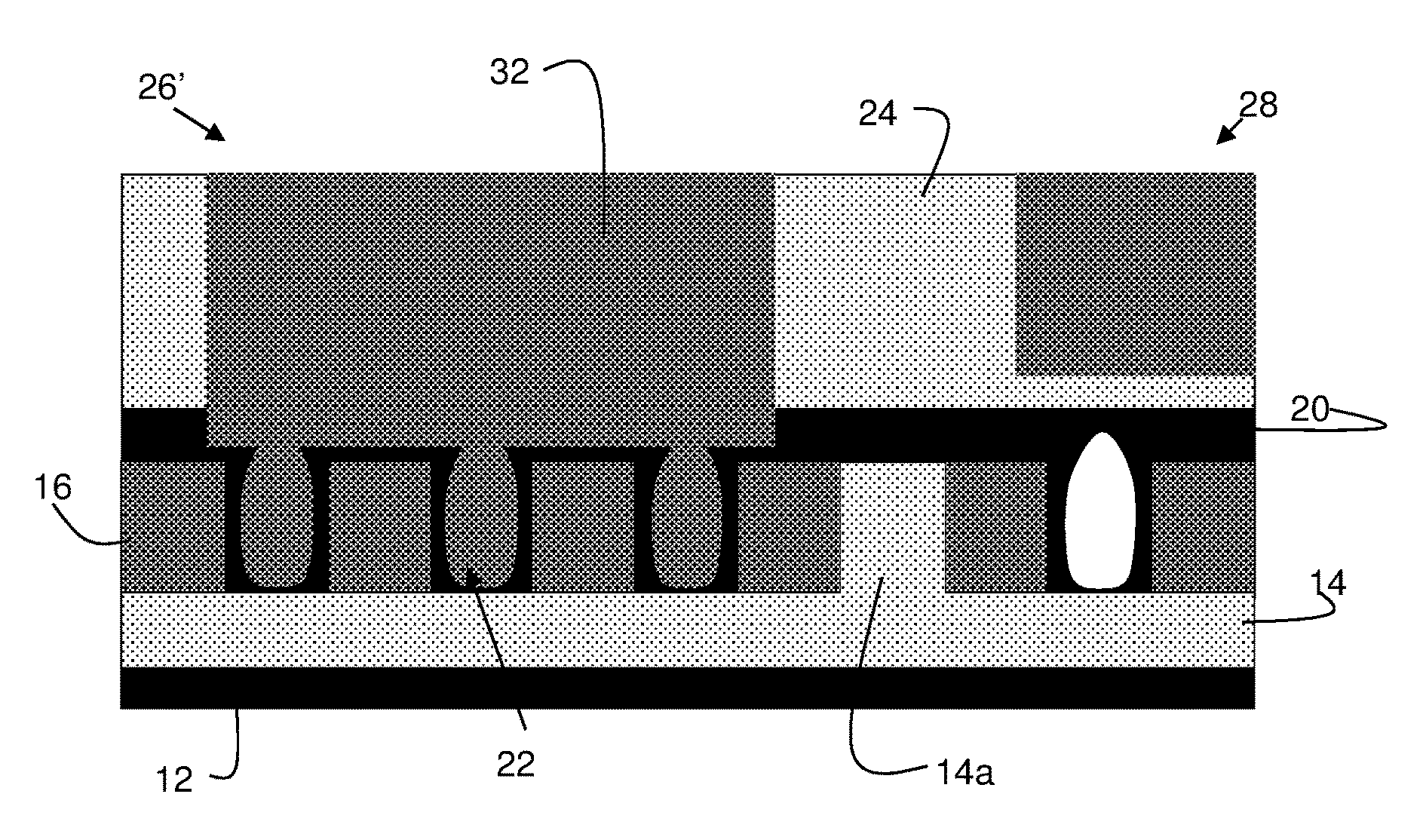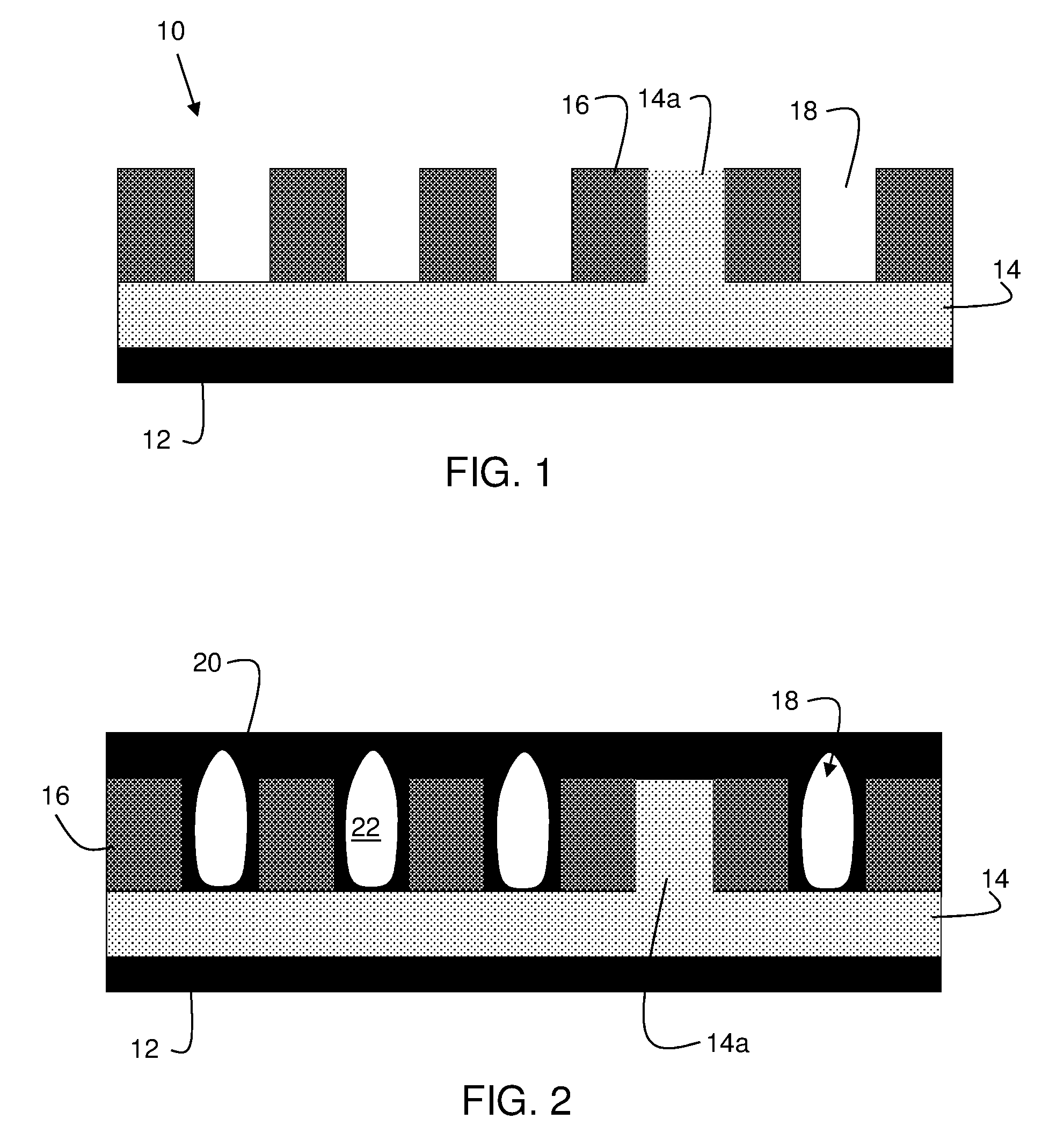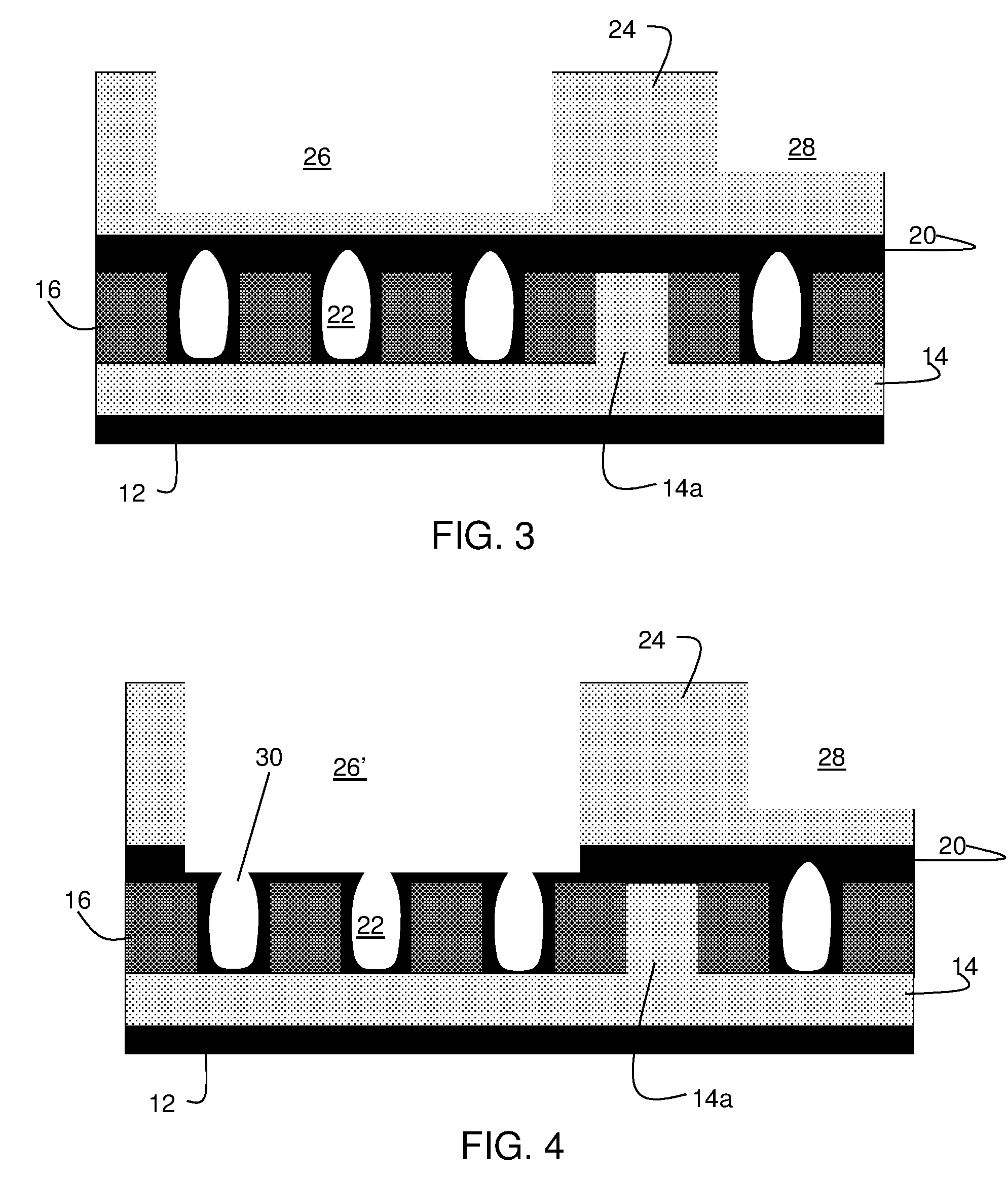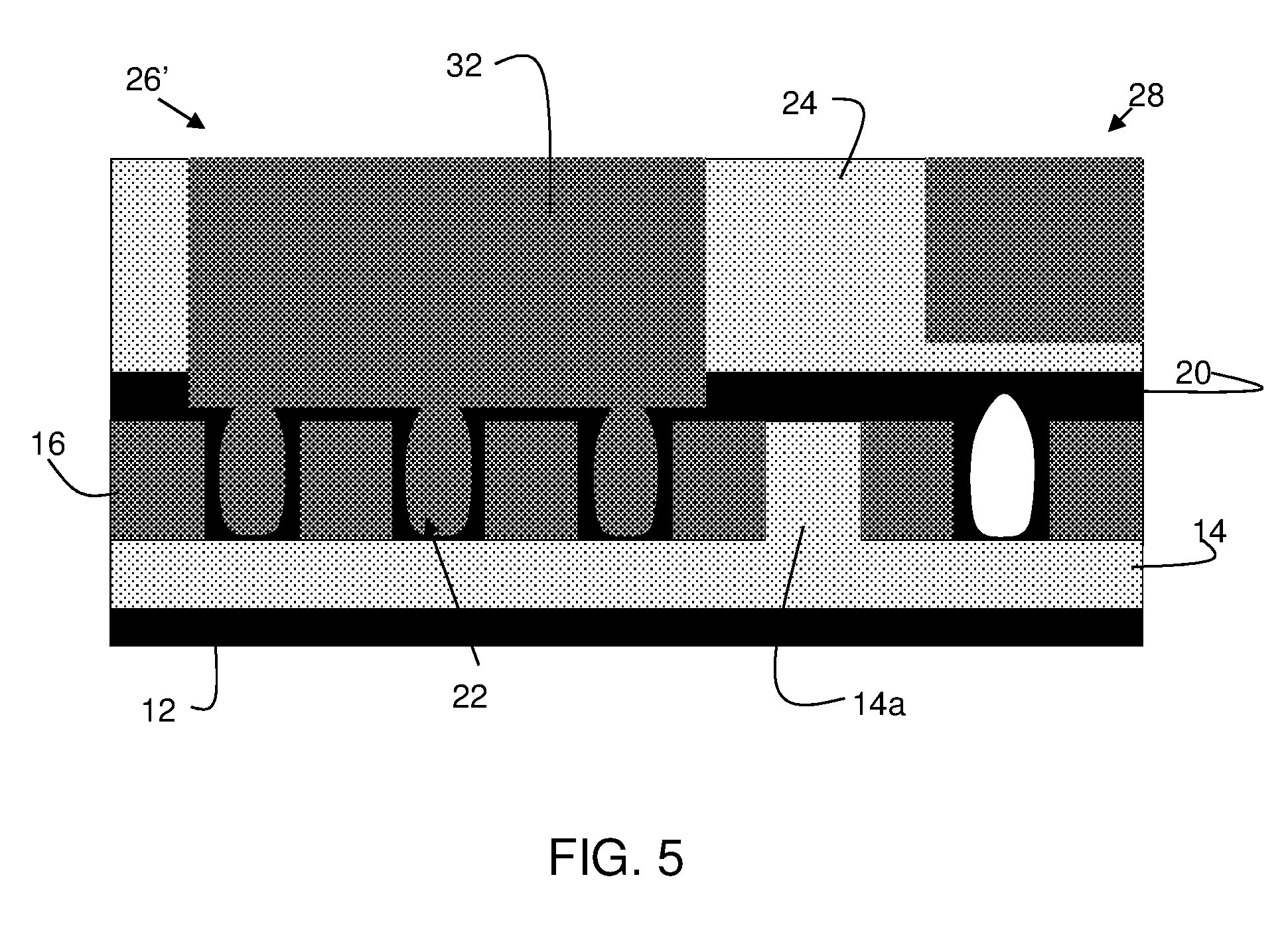Capacitors
BASKER; Veeraraghavan S. ; et al.
U.S. patent application number 16/359292 was filed with the patent office on 2019-07-11 for capacitors. The applicant listed for this patent is INTERNATIONAL BUSINESS MACHINES CORPORATION. Invention is credited to Veeraraghavan S. BASKER, Kangguo CHENG, Christopher J. PENNY, Theodorus E. STANDAERT, Junli WANG.
| Application Number | 20190214456 16/359292 |
| Document ID | / |
| Family ID | 57516094 |
| Filed Date | 2019-07-11 |




| United States Patent Application | 20190214456 |
| Kind Code | A1 |
| BASKER; Veeraraghavan S. ; et al. | July 11, 2019 |
CAPACITORS
Abstract
Back end of the line (BEOL) capacitors and methods of manufacture are provided. The method includes forming wiring lines on a substrate, with spacing between adjacent wiring lines. The method further includes forming an air gap within spacing between the adjacent wiring lines by deposition of a capping material. The method further includes opening the air gap between selected adjacent wiring lines. The method further includes depositing conductive material within the opened air gap.
| Inventors: | BASKER; Veeraraghavan S.; (Schenectady, NY) ; CHENG; Kangguo; (Schenectady, NY) ; PENNY; Christopher J.; (Saratoga Springs, NY) ; STANDAERT; Theodorus E.; (Clifton Park, NY) ; WANG; Junli; (Slingerlands, NY) | ||||||||||
| Applicant: |
|
||||||||||
|---|---|---|---|---|---|---|---|---|---|---|---|
| Family ID: | 57516094 | ||||||||||
| Appl. No.: | 16/359292 | ||||||||||
| Filed: | March 20, 2019 |
Related U.S. Patent Documents
| Application Number | Filing Date | Patent Number | ||
|---|---|---|---|---|
| 15059807 | Mar 3, 2016 | 10283586 | ||
| 16359292 | ||||
| 14736881 | Jun 11, 2015 | 9607943 | ||
| 15059807 | ||||
| Current U.S. Class: | 1/1 |
| Current CPC Class: | H01L 23/528 20130101; H01L 21/31116 20130101; H01L 28/82 20130101; H01L 23/53228 20130101; H01L 21/7682 20130101; H01L 21/76834 20130101; H01L 23/5223 20130101; H01L 21/76802 20130101; H01L 23/5222 20130101; H01L 28/60 20130101; H01L 21/76877 20130101; H01L 28/88 20130101 |
| International Class: | H01L 49/02 20060101 H01L049/02; H01L 23/522 20060101 H01L023/522; H01L 21/768 20060101 H01L021/768; H01L 23/532 20060101 H01L023/532; H01L 23/528 20060101 H01L023/528; H01L 21/311 20060101 H01L021/311 |
Claims
1. A semiconductor structure, comprising: a capacitor comprising: a bottom plate comprising a plurality of metal lines on an insulator layer; a dielectric layer lining the metal lines; and a top plate on the dielectric layer; and an other metal line on the insulator layer, wherein a portion of the insulator layer extends between and contacts sidewalls of the other metal line and one of the plurality of separate metal lines.
2. The semiconductor structure 1, further comprising a second other metal line on the insulator layer, wherein the dielectric layer encloses an air gap between the other metal line and the second other metal line.
3. The semiconductor structure 1, further comprising an etch stop layer.
4. The semiconductor structure 3, wherein the insulator layer is on the etch stop layer.
5. The semiconductor structure 1, wherein a top surface of the portion of the insulator layer contacts a bottom surface of the dielectric layer.
6. The semiconductor structure 1, further comprising an insulator material on and over the dielectric layer.
7. The semiconductor structure 6, wherein the top plate is formed in a trench in the insulator material.
8. The semiconductor structure 7, wherein the trench extends into the dielectric layer.
9. The semiconductor structure 7, further comprising a conductive material in another trench in the insulator material.
10. The semiconductor structure 9, wherein the other trench extends only partially into the insulator material.
11. A method of forming a semiconductor structure, comprising: forming a bottom plate comprising a plurality of metal lines on an insulator layer; forming a dielectric layer lining the metal lines; and forming a top plate on the dielectric layer; and forming an other metal line on the insulator layer, wherein a portion of the insulator layer extends between and contacts sidewalls of the other metal line and one of the plurality of separate metal lines.
12. The method of forming the semiconductor structure 11, further comprising forming a second other metal line on the insulator layer, wherein the dielectric layer encloses an air gap between the other metal line and the second other metal line.
13. The method of forming the semiconductor structure 11, further comprising forming an etch stop layer.
14. The method of forming the semiconductor structure 13, wherein the insulator layer is on the etch stop layer.
15. The method of forming the semiconductor structure 11, wherein a top surface of the portion of the insulator layer contacts a bottom surface of the dielectric layer.
16. The method of forming the semiconductor structure 11, further comprising forming an insulator material on and over the dielectric layer.
17. The method of forming the semiconductor structure 16, wherein the top plate is formed in a trench in the insulator material.
18. The method of forming the semiconductor structure 17, wherein the trench extends into the dielectric layer.
19. The method of forming the semiconductor structure 17, further comprising forming a conductive material in another trench in the insulator material.
20. The method of forming the semiconductor structure 19, wherein the other trench extends only partially into the insulator material.
Description
FIELD OF THE INVENTION
[0001] The invention relates to semiconductor structures and, more particularly, to back end of the line (BEOL) capacitors and methods of manufacture.
BACKGROUND
[0002] Vertical natural capacitors are on-chip capacitors that are incorporated into the interconnect levels of integrated circuits, typically during back end of line (BEOL) processes. Such capacitors are currently used as capacitor devices in many logic and analog semiconductor technologies. These capacitors may be placed in close proximity to various components on the integrated circuit in order to minimize inductive or resistive losses that may occur when using off-chip capacitors. As technology scaling continues, the capacitance density for such capacitors is expected to increase; however, as the circuit density increases, the capacitance tends to drop.
SUMMARY
[0003] In an aspect of the invention, a method comprises forming wiring lines on a substrate, with spacing between adjacent wiring lines. The method further comprises forming an air gap within spacing between the adjacent wiring lines by deposition of a capping material. The method further comprises opening the air gap between selected adjacent wiring lines. The method further comprises depositing conductive material within the opened air gap.
[0004] In an aspect of the invention, a method comprises forming wiring lines on a substrate, with spacing between adjacent wiring lines. The method further comprises forming an air gap within the spacing by depositing capping material on the wiring lines and within the spacing between the adjacent wiring until the capping material becomes pinched off. The method further comprises forming a dielectric material over the capping material including over the air gaps. The method further comprises forming a trench in the dielectric material over the air gaps. The method further comprises removing a bottom surface of the trench and underlying capping material to open the air gaps. The method further comprises depositing conductive material within the trench and within the opened air gaps.
[0005] In an aspect of the invention, a back end of line capacitor comprises: a bottom plate comprising a plurality of metal lines separated by spacing; a dielectric layer lining the metal lines within the spacing; and a top plate above the metal lines and within the spacing over the dielectric material.
BRIEF DESCRIPTION OF THE DRAWINGS
[0006] The present invention is described in the detailed description which follows, in reference to the noted plurality of drawings by way of non-limiting examples of exemplary embodiments of the present invention.
[0007] FIG. 1 shows a starting structure and respective fabrication processes in accordance with aspects of the invention.
[0008] FIG. 2 shows formation of air gaps between metal lines and respective fabrication processes in accordance with aspects of the invention.
[0009] FIG. 3 shows offset trenches and respective fabrication processes in accordance with aspects of the invention.
[0010] FIG. 4 shows an opening to the air gap from a trench and respective fabrication processes in accordance with aspects of the invention.
[0011] FIG. 5 shows a metal fill within the air gap and the plurality of trenches and respective fabrication processes in accordance with aspects of the invention.
DETAILED DESCRIPTION
[0012] The invention relates to semiconductor structures and, more particularly, to back end of the line (BEOL) capacitors and methods of manufacture. More specifically, the present invention is directed to a BEOL plate capacitor and methods of manufacturing using copper etch back and air gap processes. In embodiments, the capacitor can also be a comb pattern of wider or narrower lines. Moreover, the capacitor can land on a prior airgap level, and the lines could be perpendicular to the gaps below. Advantageously, the BEOL capacitor described herein allows for device scaling accompanied by increased capacitance density. In further embodiments, the BEOL capacitor can be used with ultra low dielectric constant materials while still allowing for device scaling and accompanied by increased capacitance density (over conventional structures). In embodiments, the BEOL capacitor is a vertical natural capacitor.
[0013] The capacitor of the present invention can be manufactured in a number of ways using a number of different tools. In general, though, the methodologies and tools are used to form structures with dimensions in the micrometer and nanometer scale. The methodologies, i.e., technologies, employed to manufacture the plate capacitor of the present invention have been adopted from integrated circuit (IC) technology. For example, the structures of the present invention are built on wafers and are realized in films of material patterned by photolithographic processes on the top of a wafer. In particular, the fabrication of the plate capacitor of the present invention uses three basic building blocks: (i) deposition of thin films of material on a substrate, (ii) applying a patterned mask on top of the films by photolithographic imaging, and (iii) etching the films selectively to the mask.
[0014] FIG. 1 shows a starting structure and respective fabrication processes in accordance with aspects of the invention. The starting structure 10 is a BEOL structure which includes an etch stop layer 12. The etch stop layer 12 protects lower wiring and device layers from BEOL processes, as well as acting as a barrier diffusion layer for copper or other metals. In embodiments, the etch stop layer 12 can be a nitride layer, SiN or SiNC (NBLOK) or bilayer-like films with silicon oxy nitride (as a 2.sup.nd layer) or other etch stop material for the upper via level.
[0015] An insulator layer 14 is formed on the layer 12. In embodiments, the insulator layer 14 can be an ultra low dielectric material, e.g., k<2.2; although other insulator materials are contemplated by the present invention. In embodiments, the insulator layer 14 can be fluorinated silica glass, carbon-doped silicon dioxide, porous silicon dioxide or spin-on organic polymeric dielectrics as examples. The insulator layer 14 can be deposited using conventional chemical vapor deposition (CVD) or plasma enhanced CVD (PECVD) processes, as examples.
[0016] Still referring to FIG. 1, a plurality of metal lines 16 are formed with spacing 18 therebetween. In embodiments, the metal lines 16 have equal line spacing 18 therebetween; although other spacing is contemplated by the present invention based on technology nodes and other design criteria. For example, the width of the metal lines 16 can be larger than the spacing 18. In any scenario, in embodiments, the metal lines 16 can be copper material forming wires or vias; although other metal or metal alloy material is also contemplated by the present invention.
[0017] The metal lines 16 can be formed using conventional damascene processes. For example, in embodiments, the insulator layer 14 can be patterned using conventional lithography and etching processes, e.g., reactive ion etching (RIE), to form openings. Conductive material, e.g., copper, can be deposited within the openings, following by a chemical mechanical polishing to planarize the metal layer and remove any residual metal material from a surface of the insulator material. The conductive material can be deposited using conventional CVD or PECVD processes, amongst other deposition processes.
[0018] The insulator material between the metal lines 16 can be removed using conventional dry etching processes, e.g., RIE, to form the spacing 18 between the metal lines 16. In embodiments, insulator material 14a can remain between selected metal lines 16 in order to provide rigidity and maintain the integrity of the structure. For example, the insulator material 14a can be aligned with an upper via or located at a position that is devoid of any critical features.
[0019] FIG. 2 shows formation of air gaps 22 between metal lines 16 and respective fabrication processes in accordance with aspects of the invention. More specifically, as shown in FIG. 2, a capping material 20 is formed over the metal lines 16 and within the spacing 18. The capping layer 20 can be deposited using a conventional CVD, PECVD or other deposition process. During the deposition process, the capping layer 20 will line the sidewalls of the metal lines 16, following by pinching off the spacing 18 forming the air gaps 22. That is, the capping layer 20 will be pinched off prior to completely filling the spacing 18, thereby resulting in capping material on the sidewalls of the metal lines and an air gap 22 within the spacing 18. The deposition process will continue until the capping material 20 forms a layer over the metal lines 16 and any insulator material 14a. The capping material 20 can optionally be planarized using a conventional CMP process. In embodiments, the capping material 20 can be nitride of other NBLOK material or other diffusion barrier material.
[0020] In FIG. 3, an insulator material 24 is deposited on the capping material 20. In embodiments, the insulator material 24 can be an ultra low dielectric material, e.g., k<2.2; although other insulator materials are also contemplated by the present invention as described herein. The insulator material 24 can be patterned to form trenches 26 and 28 using conventional lithography and etching processes as described herein. In embodiments, the trenches 26 and 28 have offset depths, e.g., trench 26 is deeper than the trench 28. In this way, the trench 26 will form part of a deep plate capacitor whereas, the trench 28 will a conventional interconnection structure, as an example.
[0021] In embodiments, the trenches 26 and 28 are formed using conventional lithography and etching (RIE) processes. For example, the trench 28 can be formed by first punching through a TiN hardmask to etch an initial depth in the insulator material. Thereafter, both trenches 26 and 28 undergo a RIE process to form the respective depths of the trenches 26 and 28. In alternative embodiments, the deeper trench 26 can be formed by an engineered reverse RIE lag process which results in a deeper trench due its larger cross sectional area (compared to the trench 28). After trench formation, any remaining masking material can be removed using an oxygen ashing process or other conventional stripping technique.
[0022] FIG. 4 shows a process to open the air gaps 22 in accordance with aspects of the present invention. By way of illustration, an etching process can be used to provide an opening 30 to the air gaps 22, by making the trench aligned with the air gaps 22 deeper as shown by reference numeral 26'. The etching process will also remove insulator material 24 from the bottom of the trench 28; however, this etching process will not open the underlying air gap(s) since trench 28 was not as deep as original trench 26.
[0023] In FIG. 5, a conductive material 32 is deposited within the trenches 26', 28, as well as within the opened air gaps 22 (and overlying the adjacent pair of bottom metal lines). In embodiments, the conductive material 32 can be copper or other metal or metal alloy deposited using any conventional deposition process such as CVD, PECVD or an atomic layer deposition (ALD). The deposition process can be followed by a reflow of the metal material 32 to ensure adequate coverage within the air gaps 22.
[0024] The conductive material 32 within the air gaps 22 can be used as grounds for a capacitor plate which comprises the metal lines 16, capping material 20 on the sidewalls of the metal lines 16, and the metal material 32. The capacitance of the structure can be set by adjusting the thickness and/or dielectric of the capping material 20 on the sidewalls of the metal lines 16.
[0025] The method(s) as described above is used in the fabrication of integrated circuit chips. The resulting integrated circuit chips can be distributed by the fabricator in raw wafer form (that is, as a single wafer that has multiple unpackaged chips), as a bare die, or in a packaged form. In the latter case the chip is mounted in a single chip package (such as a plastic carrier, with leads that are affixed to a motherboard or other higher level carrier) or in a multichip package (such as a ceramic carrier that has either or both surface interconnections or buried interconnections). In any case the chip is then integrated with other chips, discrete circuit elements, and/or other signal processing devices as part of either (a) an intermediate product, such as a motherboard, or (b) an end product. The end product can be any product that includes integrated circuit chips, ranging from toys and other low-end applications to advanced computer products having a display, a keyboard or other input device, and a central processor.
[0026] The descriptions of the various embodiments of the present invention have been presented for purposes of illustration, but are not intended to be exhaustive or limited to the embodiments disclosed. Many modifications and variations will be apparent to those of ordinary skill in the art without departing from the scope and spirit of the described embodiments. The terminology used herein was chosen to best explain the principles of the embodiments, the practical application or technical improvement over technologies found in the marketplace, or to enable others of ordinary skill in the art to understand the embodiments disclosed herein.
* * * * *
D00000

D00001

D00002

D00003

XML
uspto.report is an independent third-party trademark research tool that is not affiliated, endorsed, or sponsored by the United States Patent and Trademark Office (USPTO) or any other governmental organization. The information provided by uspto.report is based on publicly available data at the time of writing and is intended for informational purposes only.
While we strive to provide accurate and up-to-date information, we do not guarantee the accuracy, completeness, reliability, or suitability of the information displayed on this site. The use of this site is at your own risk. Any reliance you place on such information is therefore strictly at your own risk.
All official trademark data, including owner information, should be verified by visiting the official USPTO website at www.uspto.gov. This site is not intended to replace professional legal advice and should not be used as a substitute for consulting with a legal professional who is knowledgeable about trademark law.